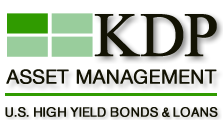The strategy’s objective since 2007 has been to obtain attractive annual returns over the long term through a blend of income and capital appreciation by allocating between senior/secured floating rate loans and defensive high yield bonds. The strategy allows for the flexibility to move into what it assesses to be the optimum asset allocation depending on the prevailing environment.
The KDP Credit Strategy actively allocates across two asset classes:
DEFENSIVE HIGH YIELD BONDS (0-100% ALLOCATION)
- Focus on better quality segment of the high yield market: target rating of Low-BB
- Minimum KDP Issuer Default Risk Ranking of 3/5 (Low-B) for all purchases
- Focus on substantial companies: typically > $50MM Cash Flow (EBITDA)
- Conservative portfolio management style: Strong emphasis on diversification with issuers <2% of strategy assets at of purchase, industries <15%
SENIOR SECURED LOANS[1] (0-100% ALLOCATION)
- Typically same credit quality and diversification requirements as Defensive High Yield Bonds
- Strategy may purchase Leveraged Loans with DRRs of lower than 3/5 provided they have a KDP Leveraged Loan Recover Ranking (RR) of A (100% Expected Recovery).
OPPORTUNISTIC CREDIT SECURITIES (0-25% ALLOCATIONS)
- Comprised of securities such as second lien loans, defaulted bonds, convertible bonds, convertible preferred securities, or distressed.
- Benchmarks: BofA Merrill Lynch High Yield BB/B Non-Distressed[2] and Credit Suisse Institutional Leveraged Loan Index[3] and the J.P. Morgan BB/B Leveraged Loan Index.
[1] Senior Secured Loans have non-investment grade status, investment in such loans is considered to be speculative. Like all other investment classes there are risks associated with investing in a portfolio of senior loans. The default risk is simply the possibility that borrower may not be able to pay interest or principal on time. This is also known as credit risk. Even though these securities pay higher interest rates there is no guarantee that the value of the collateral will be sufficient to repay the loan. Another risk associated with SSL is Call risk. When market spreads declines, senior loans are likely to be called by the issuers and refinanced at lower spreads.
[2] The BofA Merrill Lynch High Yield BB/B Non-Distressed index tracks the performance of U.S. dollar-denominated, below-investment-grade corporate debt, currently in a coupon paying period, that is publicly issued in the U.S. domestic market. Qualifying securities must have a below-investment-grade rating (based on an average of Moody's, S&P and Fitch foreign currency, long-term sovereign debt ratings). They must also have one year remaining to maturity and a minimum outstanding amount of $100 million.
[3] The Credit Suisse Institutional Leveraged Loan Index tracks the investable market of the U.S. dollar denominated leveraged loan market. It consists of issues rated "5B" or lower, meaning that the highest rated issues included in this index are Moody's/S&P ratings of Baa1/BBB+.
An investment in bonds carries risk. If interest rates rise, bond prices usually decline. The longer a bond's maturity, the greater the impact a change in interest rates can have on its price. If you do not hold a bond until maturity, you may experience a gain or loss when you sell. Bonds also carry the risk of default, which is the risk that the issuer is unable to make further income and principal payments. Other risks, including inflation risk, call risk, and pre-payment risk, also apply. High yield securities (also referred to as "junk bonds") inherently have a higher degree of market risk, default risk, and credit risk.
